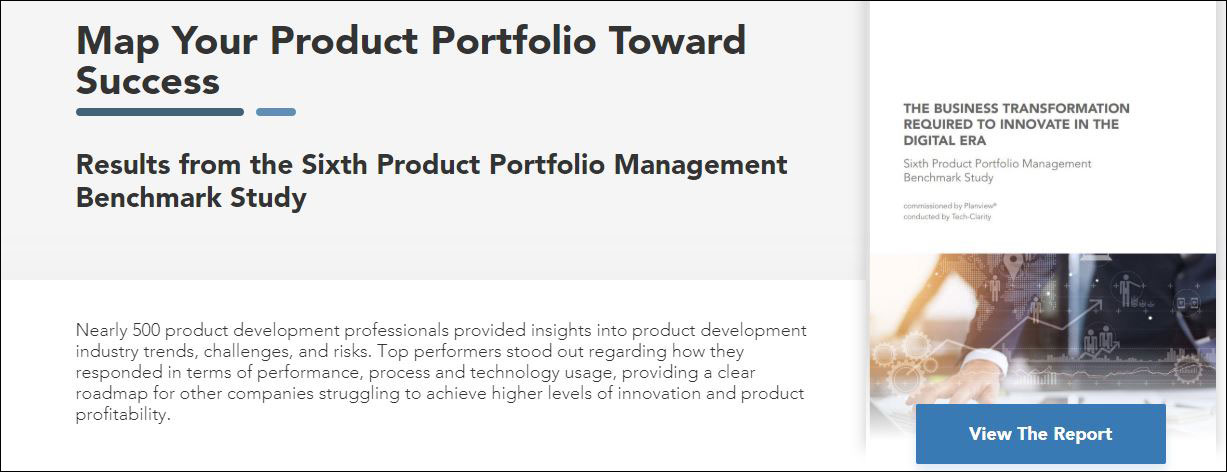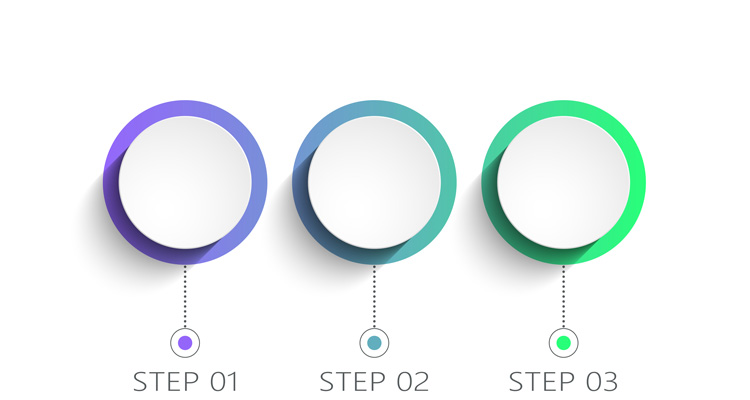
If you read parts 1 and 2 of this series “The Complexity of Managing Smarter, More Connected Products” and “Connecting Innovation Investments with Delivery,” you are probably anticipating learning the key to transforming your organization into a top performer like those we’ve cited so far. In part 3 of this 8-part series, we’ll speak to the best practices and other factors that these top performers—those who are effectively managing product portfolio challenges—have mastered.
Part 3: Modernize Your Portfolio Management Approach
As mentioned in previous series entries, Planview recently commissioned the Sixth Product Portfolio Management Benchmark Study (conducted by Tech-Clarity). In it, one of the many things we learned is that good PPM practices can help companies pick winning products to commercialize and improve time-to-market. That didn’t surprise us.
What did surprise us is that many organizations are still struggling with the same PPM challenges this study uncovered a decade ago. Several respondents stated their most pressing concerns continued to be project prioritization. In practice, they still tend to consider all projects to be high priority until they are dropped or put on hold. There was, however, an interesting improvement.
For most of the history of the survey, the number one pain point in managing product portfolios was “too many projects for available resources,” a challenge that’s been improving from 68% in 2010 to 44% in 2018. For the first time in the benchmark’s history, “decisions that go back and forth and get made late or ineffectively” is now ranked equally with the challenge of matching the volume of projects with available resources. An improvement from 53% in 2010 to the current level of 44%.
This improvement suggests that companies—especially top performers—are realizing, that project prioritization is itself a priority. That said, while respondents reported improvements in every pain point category, it’s useful to break down the current pain point ranking with a view to business impact. In order, 2018 respondents ranked pain points as follows:
- Too many projects for our resources – 44%
- Decisions that go back and forth and get made late of ineffectively – 44%
- Not being able to drive innovation fast enough (missing time to market) – 34%
- No consistent and transparent way to measure the value of projects – 33%
Understand the Business Impact
So, what actual business concerns have been induced, given the current pain-point ranking? Survey respondents were very clear: they worry most about wasting time and money. However, there is an intuitive understanding that this concern has peripheral implications that carry even greater weight.
Half of companies are failing to meet both their target revenue and their target launch dates for new product development projects. Further, it’s likely that the former is caused by the latter; you can’t realize revenue for a new product until its available. Specifically, the top three business concerns are:
- Wasted time and/or money – 49%
- Missed revenue opportunities – 36%
- Competitive disadvantage – 33%
Address the New Demand for Digital Offerings
The mandate for smarter, more connected products represents new market opportunities but it also potentially compounds the issue of relieving pain points that can induce the reported business concerns. The Benchmark Study therefore queried companies that were already delivering digital products to understand the impact to both the pain points and the concerns they are creating.
What we found was that, among the 13% already delivering smarter, more connected products, the majority said they have “significant plans to expand.” Further, more than 70% of survey participants said they are actively developing, researching, or considering adding these products. Both facts speak to the recognized market opportunity of the digital mandate—but what additional concerns does this new reality produce?
The top answer was increased complexity in the practice of developing and communicating product roadmaps, which is becoming more difficult as different departments are required to work together. IT, engineering, product development, sales, supply chain, and marketing must all now collaborate and communicated to ensure that:
- Time and money aren’t wasted
- Missed revenue opportunities are not induced
- Competitive advantage is not at risk.
Don’t Lose Your Focus
The survey indicates that top performers had a concentrated focus on product portfolio management. For example, they are three times as likely to have an “excellent” ability to accurately manage and forecast resource capacity, which is critical for making informed portfolio decisions.
They also seem to have made the connection that, to be a competitive product manufacturer in this new market of digital products and offerings, smarter technology is also the key to managing your portfolio. These top performers bring to bear this technology to prioritize the highest value products in the portfolio, optimize resource allocations across the portfolio, and balance the product mix.
Follow along with this eight-part series regarding the discipline and importance of PPM to transform your organization into one of the top performers we’ve described. In our next installment, we’ll look at the importance of data visibility and avoiding data scarcity.
Continue reading parts 4-8 of this blog series, listed below:
- Part 4: Ensuring the Life Blood of Your Business: Data Visibility
- Part 5: Product Development Processes: Changing the Game
- Part 6: Technology: The Key to Resolving Product Portfolio Challenges
- Part 7: A Product Development Process for Successful Strategic Outcomes
- Part 8: 6 Product Portfolio Management Best Practices
Also, don’t forget to read the full benchmark report “The Business Transformation Required to Innovate in the Digital Era,” and to register for the webinar, “The Surprising Secrets to Delivering Smarter, More Connected Products,” to learn more.







